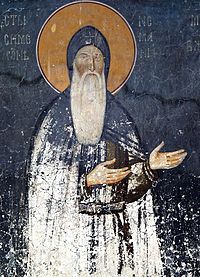Stefan Nemanja
| Stefan Nemanja | |||||
|---|---|---|---|---|---|

The fresco of Saint Simeon (Stefan Nemanja), King's Church in Studenica Monastery
|
|||||
| Grand Prince of Serbia | |||||
| Reign | 1166–1196 | ||||
| Coronation | 1166 | ||||
| Predecessor | Stefan Tihomir | ||||
| Successor | Stefan II Nemanjić | ||||
| Born | 1113/4 Ribnica |
||||
| Died | February 13, 1199 Monastery of Hilandar |
||||
| Burial | Studenica Monastery | ||||
| Spouse | Anastasia of Serbia | ||||
| Issue |
|
||||
|
|||||
| Dynasty | Nemanjić | ||||
| Father | Zavida | ||||
| Religion | Eastern Orthodox | ||||
| Signature |  |
||||
| Posthumous name | |
|---|---|
| Simeon the Myrrh-streaming |
| Stefan Nemanja | |
|---|---|

Sts. Sava and Simeon
|
|
| Saint, Venerable | |
| Venerated in | Eastern Orthodox Church |
| Canonized | 1200 by Serbian Orthodox Church |
| Feast | 26 February [O.S. 13 February] |
Stefan Nemanja (Serbian: Стефан Немања, pronounced [stêfaːn ně̞maɲa]; ca 1113 – 13 February 1199) was the Grand Prince (Veliki Župan) of the Serbian Grand Principality (also known as Rascia) from 1166 to 1196. A member of the Vukanović dynasty, Nemanja founded the Nemanjić dynasty, and is remembered for his contributions to Serbian culture and history, founding what would evolve into the Serbian Empire, as well as the national church. According to the Serbian Academy of Sciences and Arts, Nemanja is also among the most remarkable Serbs for his literary contributions and altruistic attributes.
In 1196, after three decades of warfare and negotiations which consolidated Serbia while distinguishing it from both Western and Byzantine spheres of influence, Nemanja abdicated in favour of his middle son Stefan Nemanjić, who became the first King of Serbia. Nemanja ultimately went to Mount Athos, where he became a monk and took the name of Symeon, joining his youngest son (later known as Saint Sava), who had already become the first archbishop of the Serbian Orthodox Church.
...
Wikipedia
